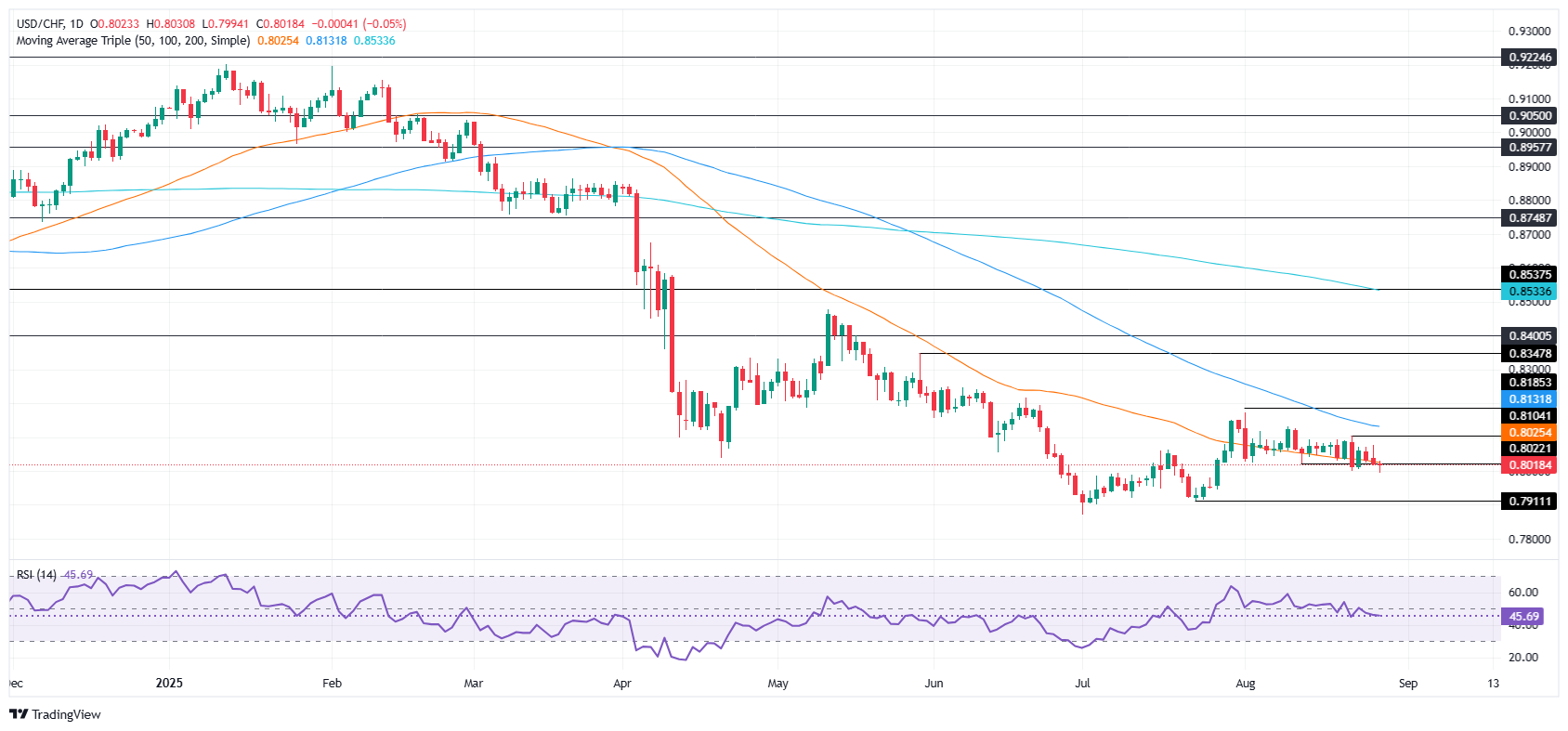USD/CHF consolidates near support, risks testing July swing lows
- USD/CHF slips 0.09% and consolidates near support after hitting a three-day low.
- Daily close below 50-day SMA could open path toward July swing lows.
- Bulls need recovery above key resistance and 100-day SMA to counter bearish momentum.
USD/CHF consolidates during the North American session yet ends Thursday’s session modestly with losses of over 0.09% even though the latest round of economic data in the United States (US) showed that the economy remains solid. At the time of writing, the pair trades at 0.8013.
USD/CHF Price Forecast: Technical outlook
The USD/CHF consolidates near the 0.8000 figure, after reaching a three-day low of 0.7994 during the session. From a price action standpoint, the pair has reached a series of lower highs and lower lows. Another daily close below the 50-day Simple Moving Average (SMA) at 0.8025 could pave the way for testing yearly lows.
Once 0.8000 is broken, the next area of interest would be the July 28 low of 0.7944, followed by the July 23 swing low of 0.7911. For a bullish reversal, the USD/CHF needs to reclaim the August 22 high of 0.8194, ahead of testing the 100-day SMA at 0.8132.
On further weakness, the next support level would be the yearly low of 0.7872.
USD/CHF Price Chart – Daily

Swiss Franc FAQs
The Swiss Franc (CHF) is Switzerland’s official currency. It is among the top ten most traded currencies globally, reaching volumes that well exceed the size of the Swiss economy. Its value is determined by the broad market sentiment, the country’s economic health or action taken by the Swiss National Bank (SNB), among other factors. Between 2011 and 2015, the Swiss Franc was pegged to the Euro (EUR). The peg was abruptly removed, resulting in a more than 20% increase in the Franc’s value, causing a turmoil in markets. Even though the peg isn’t in force anymore, CHF fortunes tend to be highly correlated with the Euro ones due to the high dependency of the Swiss economy on the neighboring Eurozone.
The Swiss Franc (CHF) is considered a safe-haven asset, or a currency that investors tend to buy in times of market stress. This is due to the perceived status of Switzerland in the world: a stable economy, a strong export sector, big central bank reserves or a longstanding political stance towards neutrality in global conflicts make the country’s currency a good choice for investors fleeing from risks. Turbulent times are likely to strengthen CHF value against other currencies that are seen as more risky to invest in.
The Swiss National Bank (SNB) meets four times a year – once every quarter, less than other major central banks – to decide on monetary policy. The bank aims for an annual inflation rate of less than 2%. When inflation is above target or forecasted to be above target in the foreseeable future, the bank will attempt to tame price growth by raising its policy rate. Higher interest rates are generally positive for the Swiss Franc (CHF) as they lead to higher yields, making the country a more attractive place for investors. On the contrary, lower interest rates tend to weaken CHF.
Macroeconomic data releases in Switzerland are key to assessing the state of the economy and can impact the Swiss Franc’s (CHF) valuation. The Swiss economy is broadly stable, but any sudden change in economic growth, inflation, current account or the central bank’s currency reserves have the potential to trigger moves in CHF. Generally, high economic growth, low unemployment and high confidence are good for CHF. Conversely, if economic data points to weakening momentum, CHF is likely to depreciate.
As a small and open economy, Switzerland is heavily dependent on the health of the neighboring Eurozone economies. The broader European Union is Switzerland’s main economic partner and a key political ally, so macroeconomic and monetary policy stability in the Eurozone is essential for Switzerland and, thus, for the Swiss Franc (CHF). With such dependency, some models suggest that the correlation between the fortunes of the Euro (EUR) and the CHF is more than 90%, or close to perfect.
